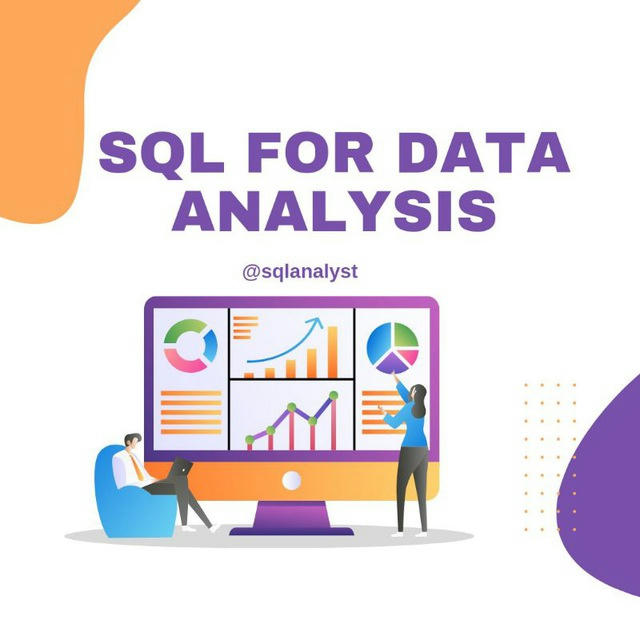
SQL for Data Analysis
Find top SQL resources from global universities, cool projects, and learning materials for data analytics. For promotions: @coderfun Buy ads: https://telega.io/c/sqlanalyst Useful links: heylink.me/DataAnalytics
Mostrar más43 157
Suscriptores
+31124 horas
+1 5447 días
+6 02630 días
- Suscriptores
- Cobertura postal
- ER - ratio de compromiso
Carga de datos en curso...
Tasa de crecimiento de suscriptores
Carga de datos en curso...
Got an Interview tomorrow? Want to practice SQL & Python online?
Applying to jobs every day is great, but remember to practice too! When you get an interview unexpectedly, you'll be well-prepared and ready to shine!
Here are a some websites that can help you with practice and cracking the interviews:
https://www.linkedin.com/posts/sql-analysts_got-an-interview-tomorrow-want-to-practice-activity-7218187268685983744-W5KC
Like for more content like this ❤️
❤ 5
Mostrar todo...
Data Analytics on LinkedIn: SQL CHEAT SHEET 👩💻
Here is a quick cheat sheet of some of the most…
SQL CHEAT SHEET 👩💻 Here is a quick cheat sheet of some of the most essential SQL commands: SELECT - Retrieves data from a database UPDATE - Updates…
🔟 Data Analyst Project Ideas for Beginners
1. Sales Analysis Dashboard: Use tools like Excel or Tableau to create a dashboard analyzing sales data. Visualize trends, top products, and seasonal patterns.
2. Customer Segmentation: Analyze customer data using clustering techniques (like K-means) to segment customers based on purchasing behavior and demographics.
3. Social Media Metrics Analysis: Gather data from social media platforms to analyze engagement metrics. Create visualizations to highlight trends and performance.
4. Survey Data Analysis: Conduct a survey and analyze the results using statistical techniques. Present findings with visualizations to showcase insights.
5. Exploratory Data Analysis (EDA): Choose a public dataset and perform EDA using Python (Pandas, Matplotlib) or R (tidyverse). Summarize key insights and visualizations.
6. Employee Performance Analysis: Analyze employee performance data to identify trends in productivity, turnover rates, and training effectiveness.
7. Public Health Data Analysis: Use datasets from public health sources (like CDC) to analyze trends in health metrics (e.g., vaccination rates, disease outbreaks) and visualize findings.
8. Real Estate Market Analysis: Analyze real estate listings to find trends in pricing, location, and features. Use data visualization to present your findings.
9. Weather Data Visualization: Collect weather data and analyze trends over time. Create visualizations to show changes in temperature, precipitation, or extreme weather events.
10. Financial Analysis: Analyze a company’s financial statements to assess its performance over time. Create visualizations to highlight key financial ratios and trends.
I have curated best 80+ top-notch Data Analytics Resources 👇👇
https://topmate.io/analyst/861634
Hope this helps you 😊
👍 5❤ 1
Best practices for writing SQL queries:
1- Filter Early, Aggregate Late: Apply filtering conditions in the WHERE clause early in the query, and perform aggregations in the HAVING or SELECT clauses as needed.
2- Use table aliases with columns when you are joining multiple tables.
3- Never use select *, always mention list of columns in select clause before deploying the code.
4- Add useful comments wherever you write complex logic. Avoid too many comments.
5- Use joins instead of correlated subqueries when possible for better performance.
6- Create CTEs instead of multiple sub queries, it will make your query easy to read.
7- Join tables using JOIN keywords instead of writing join condition in where clause for better readability.
8- Never use order by in sub queries, It will unnecessary increase runtime. In fact some databases don't even allow you to do that.
9- If you know there are no duplicates in 2 tables, use UNION ALL instead of UNION for better performance.
👍 14🎉 3
Mostrar todo...
Data Analytics on LinkedIn: A beginner's roadmap for learning SQL 📊🚀
🔹Understand Basics:
Learn…
A beginner's roadmap for learning SQL 📊🚀 🔹Understand Basics: Learn what SQL is and its purpose in managing relational databases. Understand basic database…
Essential SQL Topics for Data Analysts
- Basic Queries: SELECT, FROM, WHERE clauses.
- Sorting and Filtering: ORDER BY, GROUP BY, HAVING.
- Joins: INNER JOIN, LEFT JOIN, RIGHT JOIN.
- Aggregation Functions: COUNT, SUM, AVG, MIN, MAX.
- Subqueries: Embedding queries within queries.
- Data Modification: INSERT, UPDATE, DELETE.
- Indexes: Optimizing query performance.
- Normalization: Ensuring efficient database design.
- Views: Creating virtual tables for simplified queries.
- Understanding Database Relationships: One-to-One, One-to-Many, Many-to-Many.
Window functions are also important for data analysts. They allow for advanced data analysis and manipulation within specified subsets of data.
Commonly used window functions include:
- ROW_NUMBER(): Assigns a unique number to each row based on a specified order.
- RANK() and DENSE_RANK(): Rank data based on a specified order, handling ties differently.
- LAG() and LEAD(): Access data from preceding or following rows within a partition.
- SUM(), AVG(), MIN(), MAX(): Aggregations over a defined window of rows.
Here you can find essential SQL Interview Resources👇
https://topmate.io/analyst/864764
Like this post if you need more 👍❤️
Hope it helps :)
👍 12❤ 4
Elige un Plan Diferente
Tu plan actual sólo permite el análisis de 5 canales. Para obtener más, elige otro plan.

 Network:
Network: